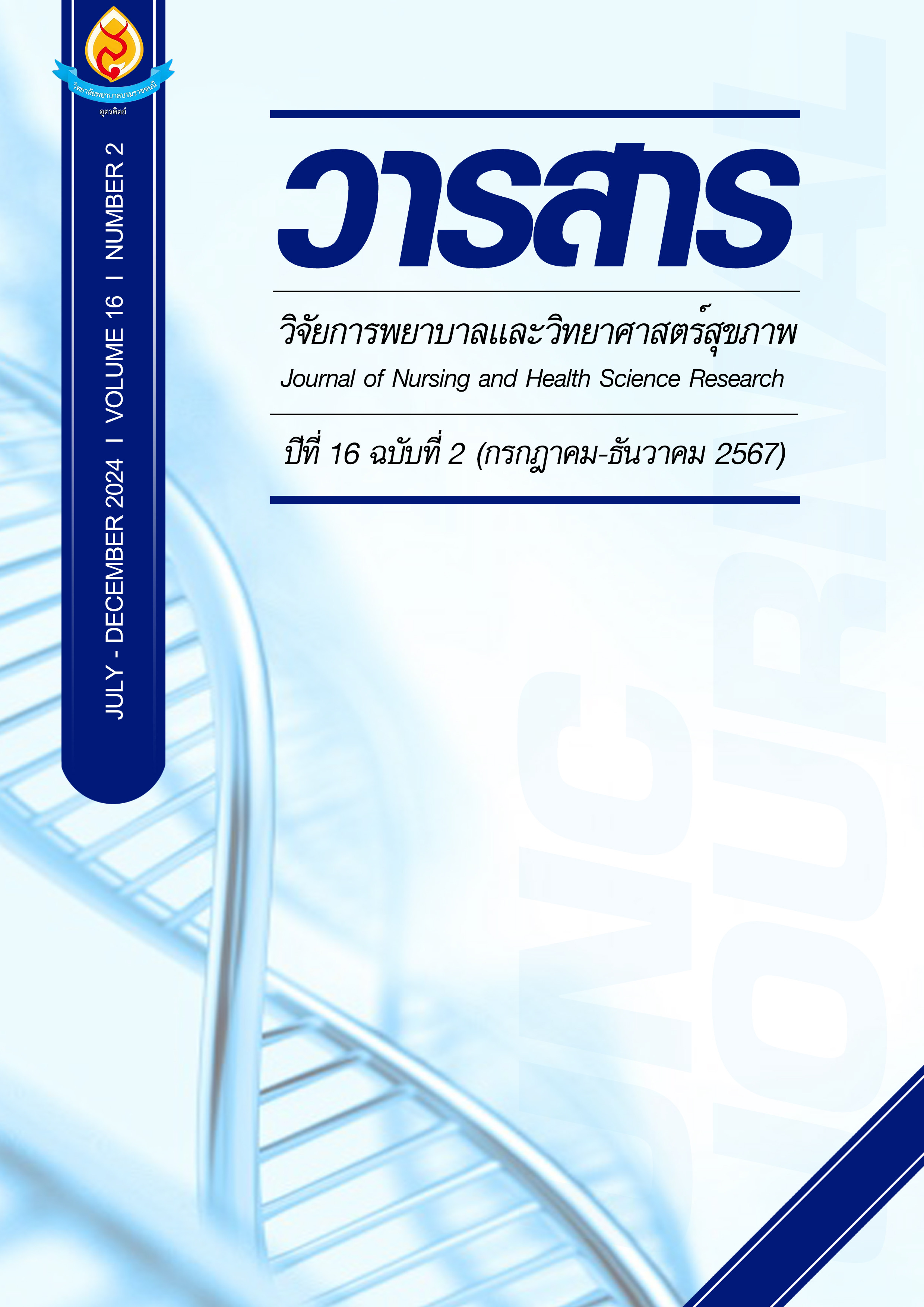ผลของโปรแกรมการจัดการตนเองของบุคคลและครอบครัว ต่อความร่วมมือในการใช้ยาขับเหล็กในเด็กวัยเรียนโรคธาลัสซีเมีย
Main Article Content
บทคัดย่อ
การวิจัยกึ่งทดลองนี้มีวัตถุประสงค์เพื่อศึกษาโปรแกรมการจัดการตนเองของบุคคลและครอบครัว ต่อความร่วมมือในการใช้ยาขับเหล็กของผู้ป่วยเด็กวัยเรียนโรคธาลัสซีเมีย กลุ่มตัวอย่างเด็กวัยเรียนโรคธาลัสซีเมีย จำนวน 36 คน คัดเลือกแบบเจาะจงโดยเป็นผู้ป่วยเด็กโรคธาลัสซีเมีย อายุ 7-12 ปี เข้ารับบริการแผนกผู้ป่วยนอก โรงพยาบาลลำปาง แบ่งเข้ากลุ่มควบคุมและกลุ่มทดลอง กลุ่มละ 18 คน โดยกลุ่มควบคุมได้รับการพยาบาลตามปกติ และกลุ่มทดลองได้รับโปรแกรมการจัดการตนเองของบุคคลและครอบครัว ระยะเวลา 8 สัปดาห์ เครื่องมือวิจัยคือแบบสอบถามข้อมูลส่วนบุคคลและแบบประเมินความร่วมมือในการใช้ยาของมอริสกี้ ฉบับภาษาไทย 8 ข้อ ซึ่งตรวจสอบความเชื่อมั่น KR 20 เท่ากับ .82 วิเคราะห์ข้อมูลโดยใช้สถิติเชิงพรรณนาและการทดสอบที
ผลการวิจัยพบว่าความร่วมมือในการใช้ยาขับเหล็กของเด็กวัยเรียนโรคธาลัสซีเมียภายหลังการเข้าร่วมโปรแกรมฯ สูงกว่าก่อนการเข้าโปรแกรมฯ อย่างมีนัยสำคัญทางสถิติที่ระดับ .001 ความร่วมมือในการใช้ยา ขับเหล็กของเด็กวัยเรียนโรคธาลัสซีเมีย กลุ่มที่เข้าร่วมโปรแกรมฯ สูงกว่ากลุ่มที่ได้รับการดูแลตามปกติอย่างมีนัยสำคัญทางสถิติที่ .001
ผลจากการศึกษาครั้งนี้เสนอแนะว่าควรมีการสนับสนุนบุคลากรด้านสุขภาพในการใช้โปรแกรมการจัดการตนเองของบุคคลและครอบครัวของเด็กวัยเรียนโรคธาลัสซีเมีย เพื่อเพิ่มความเข้าใจในการใช้ยาขับเหล็กและส่งเสริมพฤติกรรมความร่วมมือในการใช้ยาขับเหล็กได้อย่างมีประสิทธิภาพ
Article Details

อนุญาตภายใต้เงื่อนไข Creative Commons Attribution-NonCommercial-NoDerivatives 4.0 International License.
บทความหรือข้อคิดเห็นใดใดที่ปรากฏในวารสารวิจัยการพยาบาลและวิทยาศาสตร์สุขภาพ เป็นวรรณกรรมของผู้เขียน ซึ่งบรรณาธิการหรือสมาคมศิษย์เก่า ไม่จำเป็นต้องเห็นด้วย และบทความที่ได้รับการตีพิมพ์เผยแพร่ถือเป็นลิขสิทธิ์ของวารสารวิจัยการพยาบาลและวิทยาศาสตร์สุขภาพ
เอกสารอ้างอิง
Busabawalai, T., Punchai, A., Uansri, S., Thangsungnoen, K. & Onjorn, O. (2019). Evaluation of the project to prevent and control thalassemia in pregnancy (HITAP). Retrived (2019, January 3). from https://www.hitap.net/research/173411 (in Thai).
Cappellini, C. A., Porter, J., Taher, A. & Viprakasit, V. (2016). Thalassemia international federation. Retrived (2019, January 3). from https://issuu.com/internationalthalassaemiafederation/docs/tif_guidelines_for_management_final
Charoensatsiri, R., Saritpaisan, L. & Nithirat, P. (2020). Model for promoting and supporting families in caring for pediatric leukemia patients receiving chemotherapy at Prapokklao hospital. Hua Hin Medical Journal, 5(3), 16-28. (in Thai).
Cherry, K. (2020). Piaget’s 4 stages of cognitive development explained: background and key concepts of Piaget's theory. Retrived (2020, May 2). from https://www.verywellmind.com/piagets-stages-of-cognitive-development-2795457
Department of Medical Services. (2018). Thalassemia. A concern genetic disease of Thailand Bureau of Information Office of The Permanent Secretary of MOPH. Retrived (2020, May 2). from https://pr.moph. go.th/?url=pr/detail/all/02/116500 (in Thai).
Khyate, M. A., Althanoon, Z. A. & Alkazaz, N. A. (2020). Adherence and satisfaction of deferasiroxversus deferoxamine in transfusion-dependent beta-thalassemia. Indian Journal of Forensic Medicine & Toxicology, 14(4), 1028-1033.
Pianwittayaphan, R. (2018). Safety and effectiveness of deferiprone (GPO-L-ONE®) in children thalassemia patient with Iron overload at Sirikit National Institute of Child Health. Journal of the Department of Medical, 43(3), 108-113. (in Thai).
Prabmeechai, S. & Rueangworabun, S. (2017). Effects of animation media on knowledge and self - care behavior of school-age children with thalassemia. Nursing Journal of the Ministry of Public Health, 27(2), 96-109. (in Thai).
Promprakob, V., Sananreangsak, S. & Teerarungsikul, N. (2020). Effects of the self-management program on asthma control behaviors of school-age children with Asthma. Journal of Nursing and Health Sciences, 14(1), 110-121. (in Thai).
Ryan, P. & Sawin, K. J. (2009). The individual and family self-management theory: Background and perspectives on context, process, and outcomes. Nursing Outlook, 57(4), 217-225, e216. doi.org/10.1016/j.outlook.2008.10.004
Saengthong, W., Haohan, C. & Phaenthong, W. (2020). Effects of supporting system and formal education on knowledge and self-care behavior of school-aged children with thalassemia. The Southern College Network Journal of Nursing and Public Health, 7(2), 39-50. (in Thai).
Sanguanphong, Y. & Thongsawang, K. (2021). Illness experiences of school age children with thalassemia in Chaiyaphum province. Regional Health Promotion Center 9 Journal, 15(37), 262-281. (in Thai).
Sananruangsak, S., Teerarangsikun, N., Sarapat, P. & Phinyo, M. (2020). Self-management model of children with thalassemia. The Journal of Faculty of Nursing Burapha University, 28(2), 27-29. (in Thai).
Shosha, G. M. (2016). Beliefs of jordanian children with Thalassemia toward using iron chelation therapy. Open Journal of Blood Diseases, 6, 23-32.
Smith, Y. (2021). Thalassemia prevalence. News medical life sciences. Retrived (2021, May 22). from https://www.news-medical. net/ health/Thalassemia-Prevalence.aspx
Susanah, S., Idjradinata, P. S., Sari, N. M., Rakhmilla, L. E., Sribudiani, Y., Trisaputra, J. O. & Moestopo, O. (2020). Time to start delivering iron chelation therapy in newly diagnosed severe beta-thalassemia. BioMed Research International, 2020, Article 8185016. doi.org/10.1155/2020/8185016
Theppornpitak, K., Trakarnsanga, B., Lauhasurayotin, S., Poparn, H., Chiengthong, K., Sosothikul, D. & Techavichit, P. (2021). A study to assess and improve adherence to iron chelation therapy in transfusion-dependent thalassemia patients. International Journal for Hemoglobin Research, 3(45), 171-174. doi.org/10.1080/03630269.2021.1934010
Torjarat, K. (2017). Diagnosis and screening of carriers in Buakhao J, Guidelines for thalassemia in general practice. (p.17-24 ). Business Office War Veterans Organization. (in Thai).
Wanngamwiset, S., Nookong, A. & Payakkaraung, S. (2019). Factors predicting medication adherence in school-aged children. Journal of Health Science Research, 13(2), 20-29. (in Thai).
Wiprakasit, W. (2013). Integrated care for thalassemia. Journal of Hematology and Transfusion Medicine, 23(4), 303-320. (in Thai).


